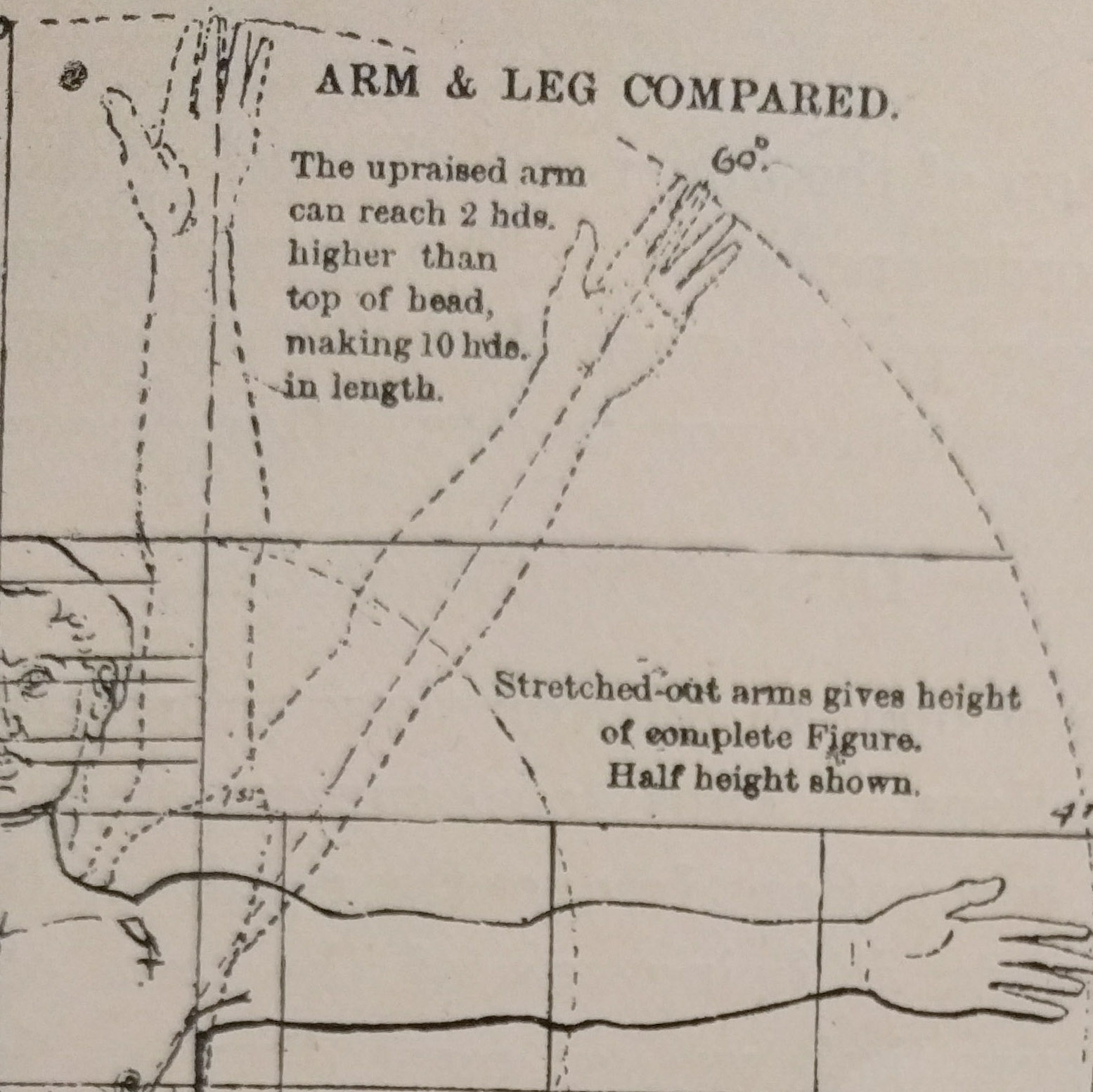External Anatomy
This is third part of the book – dealing with External Anatomy and the Proportions of the Body
External anatomy
In order to make clothing intelligently it is desirable that we should be acquainted with the leading features of the body we have to clothe, and as there is universal agreement amongst scientists that the human figure is the masterpiece of creation, it is but natural that we should expect to find some traces of design. Now, you know that when a builder is putting up a house he erects a scaffolding and then builds his walls; just so the builder of our bodies has erected scaffolding and built walls to the house we live in. The scaffolding is the bones, the walls are the muscles, and the skin is the beautiful covering given to the walls.
The Bone Framework
Now, it is my desire to call attention to a few of the more noticeable features of anatomy, as they will be of service to tailors. In the bones are to be found three different kinds of joints, and as these govern the movements of the body a knowledge of these peculiarities will help us to know what movements are possible. The first joint of every limb has a ball and socket movement, which has been so arranged by our Creator that the freest possible movement might be obtained. Thus the first joint of the arms, the legs, the hands, the fingers, and the toes are all of the cup and ball order; these are all marked 1 on the figure. The second joint of each limb is of the hinged pattern, which moves only in two directions, like the door of a room, to and fro, and this shows us that a sideways movement is impossible where it is found, viz., the knee, the finger, second and third joint; the elbow is also of this character, but it is so wonderfully formed that a greater liberty is given to it by a rolling power; still, for our purpose we may classify it as a hinge-joint. The third kind is the gliding joint, which gives a great variety of movements of a limited character; these are found in the backbone, the arch of the wrist, and the arch of the foot. The movement allowed by these joints is seen the eel and the snake, but as they do not have much bearing on tailoring we may pass onto our next item, viz., the parts of the body where the bones always remain near the surface of the skin, and here we have a lesson of the utmost importance for tailors, as it enables us to decide where alterations should be made in the cut where figures are larger or smaller than usual.
It will be well for you to examine your own body to prove the truth of what is here stated, as well as to impress the lessons on the mind.
The bones which always remain near the surface of the skin are:-
Spine or back bone (A A)
Shoulder bone (B B)
Elbow (C C)
Hip bone(D D)
Thigh bone (E E)
Shin bone (F F)
Ankle bone (G G)
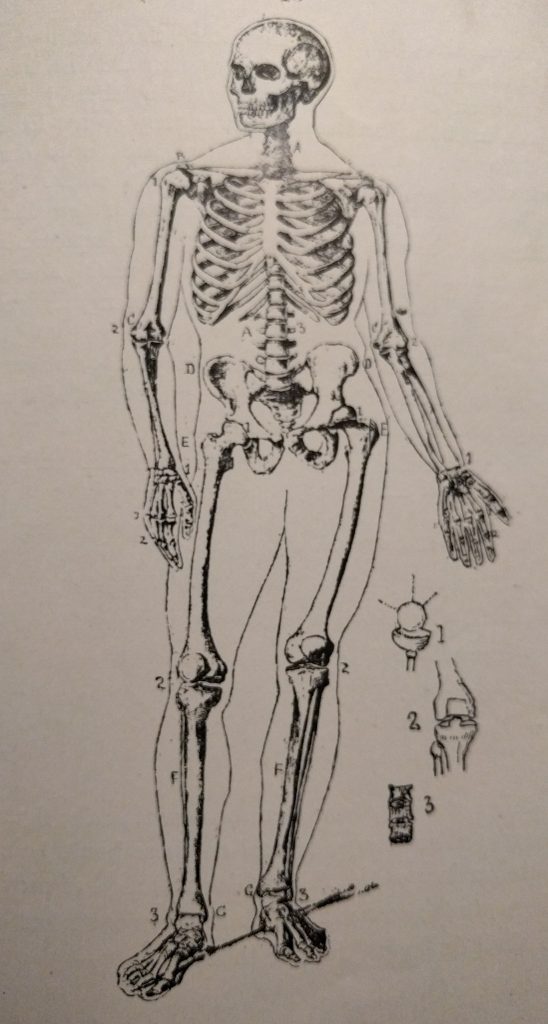
It does not matter how stout or how thin the figure may be, you can always depend on these bones being near the surface of the skin, which means that provision for extra size must be made at other parts, butt of this I shall deal with more fully later.
Another point worthy of note is that the human body is symmetrical, which means that the right side is the same shape as the left, and, generally speaking, the same size, only in reverse. Consequently, when cutting out a coat, vest, or trousers, we cut it two thicknesses at a time, the material being arranged face to face, so that only one piece shall cover the right side and the other cover the left.
These points indicate design and law, and beautifully illustrate the wisdom and love of our Creator, so that feel compelled to exclaim: “Truly, we are fearfully and wonderfully made!”
Let us now devote a little time to the consideration of the walls of the house we live in. These, as I have previously stated, are the…
Muscles and Flesh
And some of the lessons all tailors have to learn are the laws which govern the the distribution of (a) the muscles and (b) fat. Now, if you look at the figure of the skeleton given a few pages back you will see that the bones do not by any means go through the centre of the limbs. Take, for instance, the thigh, you will observe by far the larger amount of flesh is on the inside of the the the leg. Now, the study of external anatomy teaches us that the figure we have to clothe is by no means a flat surface, but, rather, one that abounds in prominences and depressions, or, in other words, there are any number of little mountains and valleys over which we have to arrange the cloth. Look, for instance, at this very beautiful portrait of Sandow, the champion strong man, which we publish by kind permission of Mr L Graham Lewis, manager to the makers of Sandow’s own developer, which, by the bye, is a splendid instrument for the development of the body. The prominences of the body we have to principally provide for are: At the back, the shoulder blades, and the seat; at the front, the breast and the stomach. You will particularly notice that these exist on both sides of the figure, and that between them there are depressions or hollows, so that down the centre of the back there is a hollow, and another down the centre of the front.
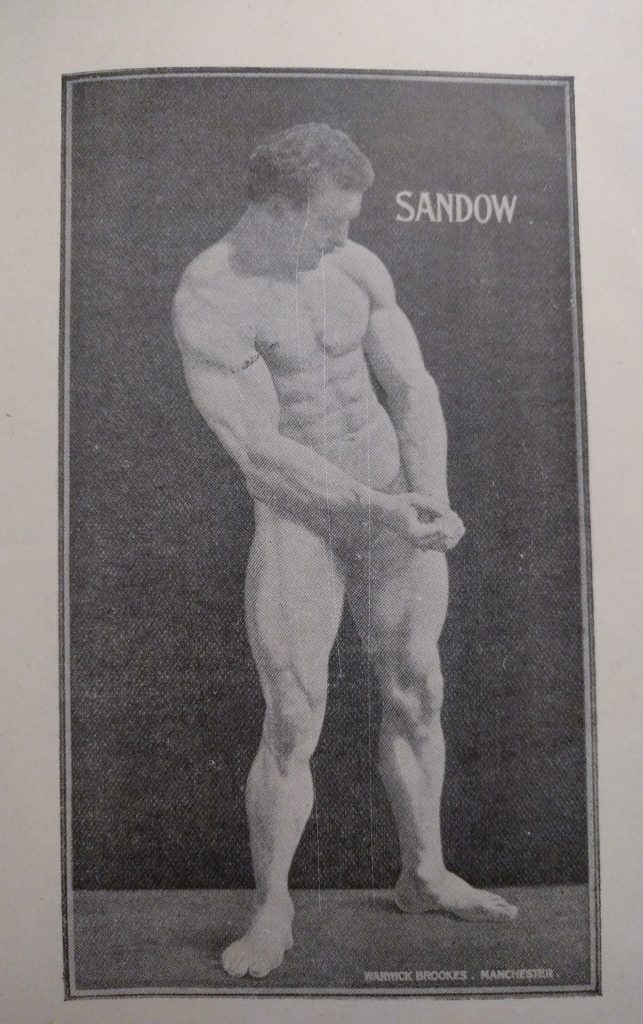
Fatty Increment
Now, in addition to the muscular development, we have to deal with fatty increases, and the accompanying figure shows the development of the body in that way.
When a man becomes corpulent the increase take place mostly at the front, as indicated by the dotted lines. The rule used by tailors is to the effect that two thirds of the increase takes place at the front and one third at the sides. The thigh increases on the top and on the insides, and the calf enlarges at the back; the increase at the armpit is as shown by dotted lines. It is also a noticeable fact that as a man gets stout his arms become shorter, although the distance from centre of back to finger tips measures the same, but the increased width of back reduces the length of arms. This same principle also operates with the legs, they become shorter as the figure gets stouter, the total height remains the same, but the increased size of the body reduces the length of the leg.
When Barnum, the celebrated showman, was over here he had quite a number of natural eccentricities, but these in nearly every case illustrated the laws here laid down. If you get an opportunity, you will do well to learn the names of the various bones and muscles and make yourself acquainted with their movements, but this is not absolutely necessary, and must be looked upon as an additional study that will enlarge your mind and make you more intelligent.
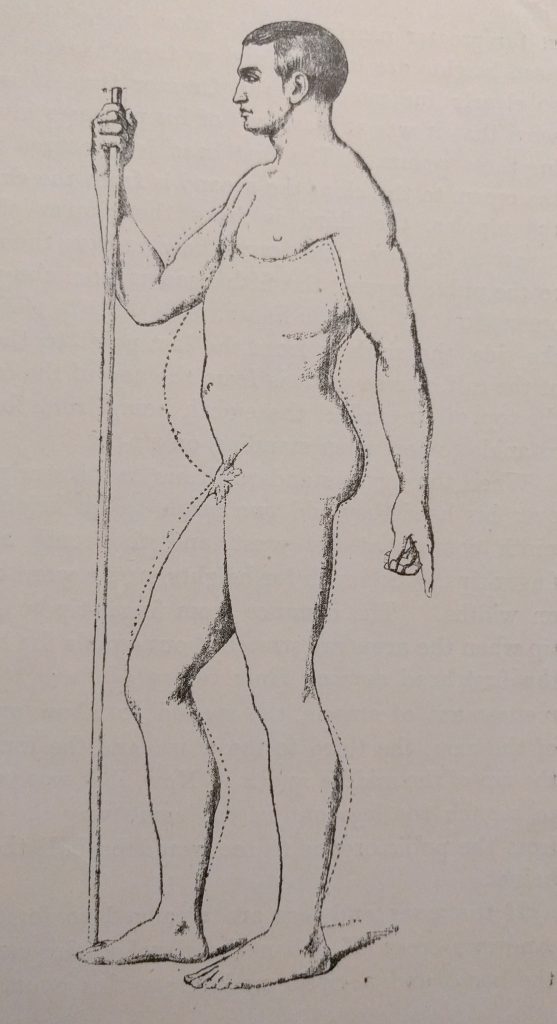
Proportions of the Body
I want to call the attention of my young readers to the various proportions of the body; these are so clearly defined that they will be easily remembered. To begin with, it will be necessary for you to understand that it is the custom of all students of this subject to reckon by so many heads, so they speak of the height of the body as being seven-and-a-half heads, just as we speak of our height being so many feet and inches. The head is measured from the top to the chin, and this is as a rule equal to rather more than one-eighth of the height when standing naturally, and is as nearly as possible one eighth of the height of the figure when standing on tip-toe. Now, that in itself is useful for you to know, but it will be of far greater use for you to know where the other head heights are located, and as these have all been so clearly indicated by the Creator that it would seem that it was at least one of his purposes in placing the points. The first head is measured from the crown to the chin, the second from the chin to the nipples, the third is from the nipples of the breast to the navel, the fourth head is from the navel to the pubic organs, the fifth head is from the pubic organs to the tip of the finger with the arm placed at the side, the sixth is from the last point to the top of the calf, the seventh is from the top of the calf to the top of the ankle, the eighth being from the top of ankle to toe when standing on tip-toe.
When the figure stands with his hands straight up over his head they add two heads to his height, the ninth coming at the wrist, and the tenth at the finger tips. So much for heights, now a word or two on widths. The distance from fingertip to fingertip when the arms are stretched out equals the height, the first head coming from centre of back to commencement of muscle, the second to elbow or bend of the arm, the third to the wrist, and the fourth to the tip of the middle finger. Now if it was possible to stretch the legs out in the same way the length from the pubic organs to toe would be half the total height.
If the arms and legs are arranged to form a St Andrews cross (X), then the navel is the centre of the body and a circle made from this point would touch the top of the finger and the end of the toe, or, in other words, enclose it. The figures given on this page will help you to grasp these facts, and these will prove very useful to you in your after career.
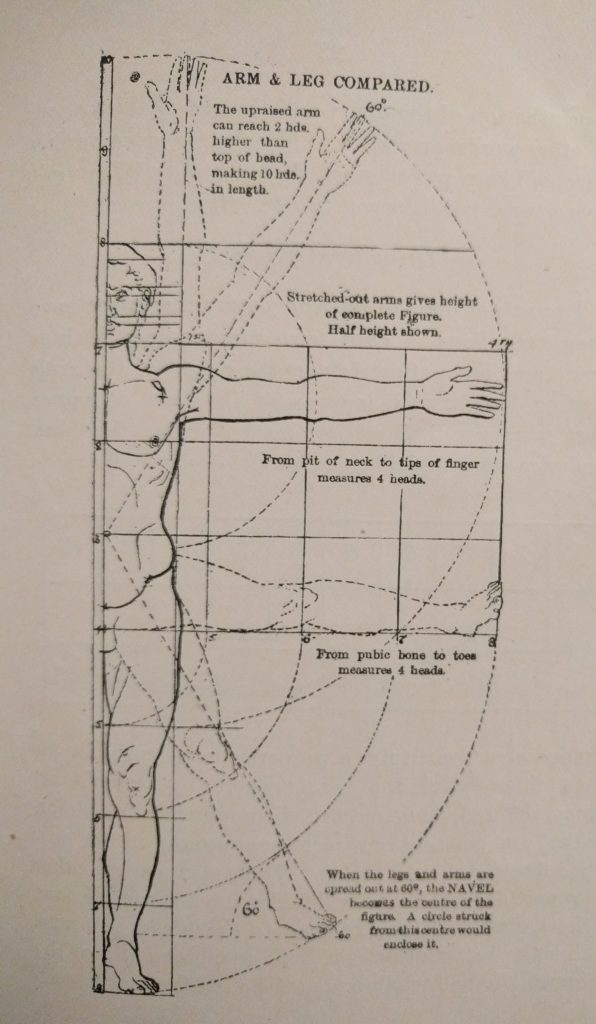
Disproportion
I must not omit to tell you these proportions have their exceptions. Thus, local surroundings, such as trade and occupation, frequently result in the arms getting longer, it being one of the laws of nature that whatever limb we use most develops the most and vice-versa.
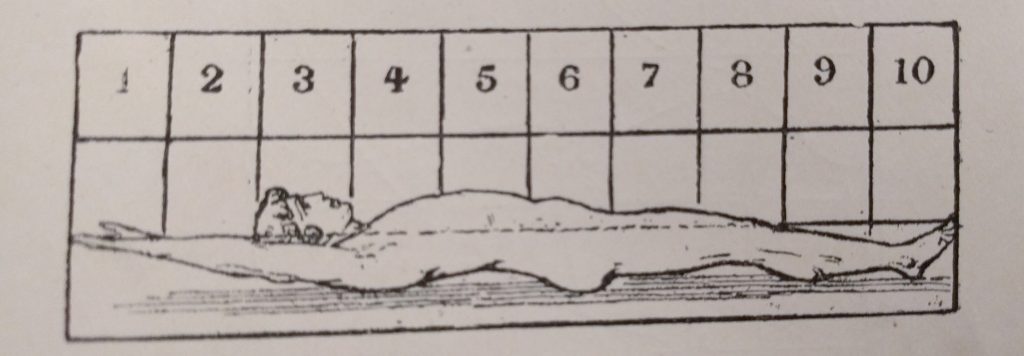
Still, it is always desirable for us to know what constitutes a proportionate figure, for we can then detect the points where the tailor’s art may be used, toning down disproportion and deformity, and making our customers appear in the best possible shape and style. There are several other proportions which you will find it interesting to know, these, however, have relation to the breast measure, this the half width of the back equals one fifth of the breast, the half width across the chest is equal to one fourth of the breast, less one inch; the size of the neck is is equal to five twelfths of the breast; the size of the scye or armhole is one half breast, less one inch; the length of shoulder from centre of neck at back to bottom of armpit in front is one third breast with 1/2 inch added. The waist is equal to about five sixths of the breast, and the hips are one inch larger than chest. There are many other proportions of this sort, and they are all very useful, but these are the most important, and you should commit them to memory.
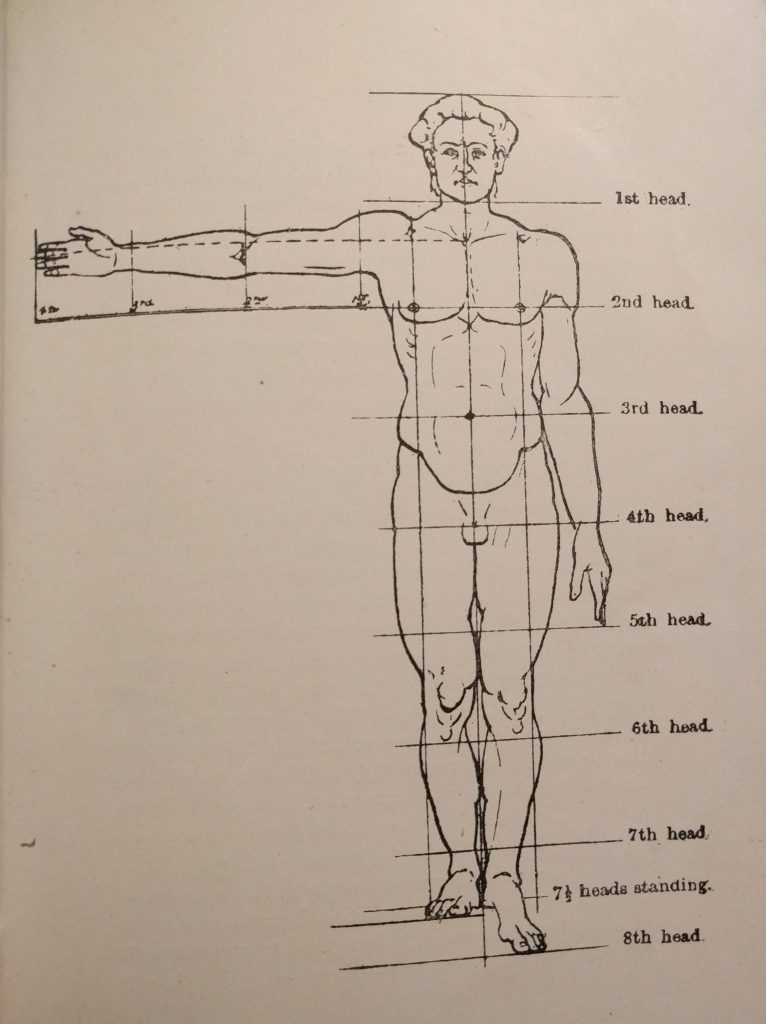
Taken from “The Tailor’s Handbook of Useful Information” by W.D.F. Vincent c1905
The following link – correct at the time of publication – gives further reading about Sandow
➡ The Tailor’s Handbook of Useful Information
- The Noble Army of Tailors
- The Advantages of Tailoring
- The Ninth Part of a Man
- External Anatomy
- History and Philosophy of Clothes
- Origins of clothes and writings for tailors
- Where do the materials to make clothes come from – part two
- Where do the materials to make clothes come from – part one

